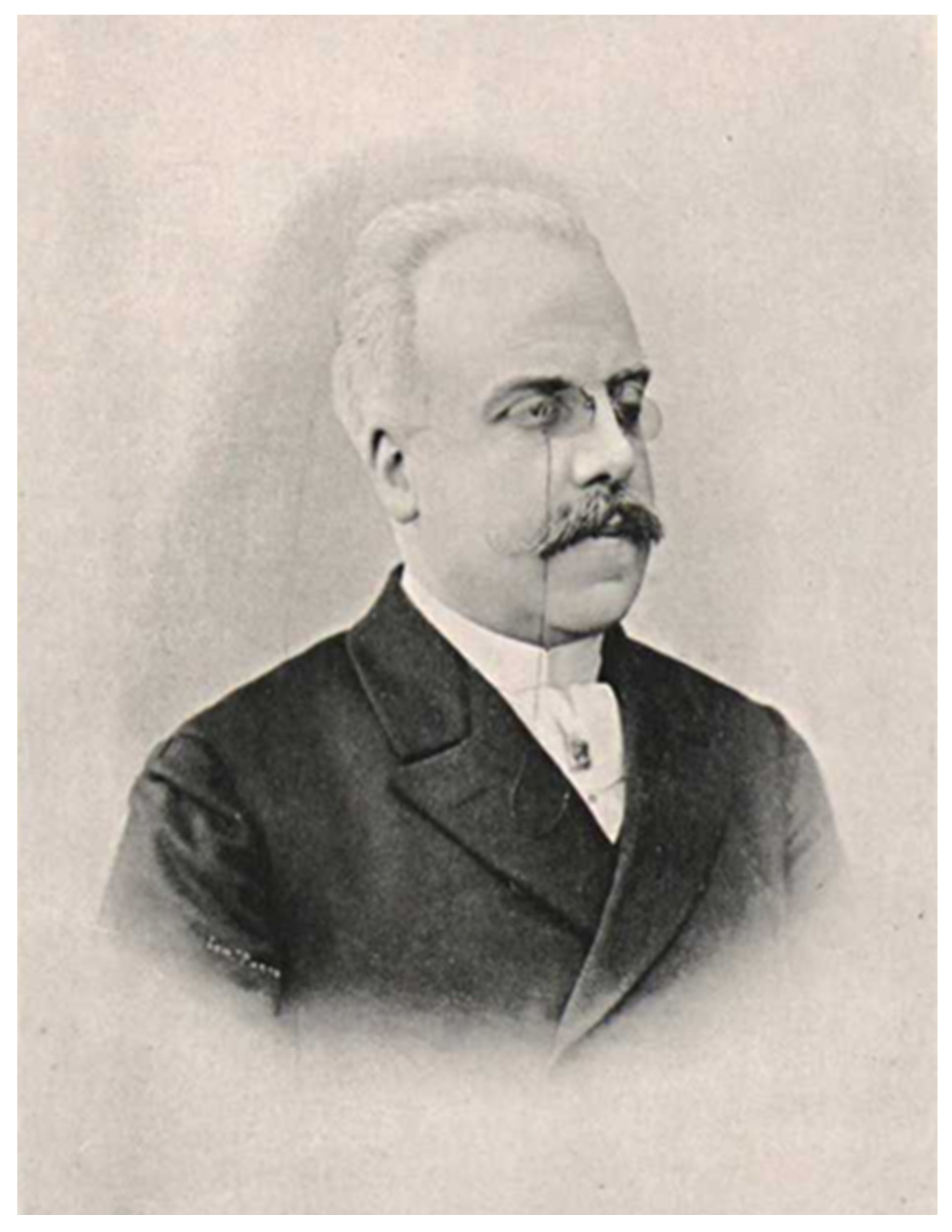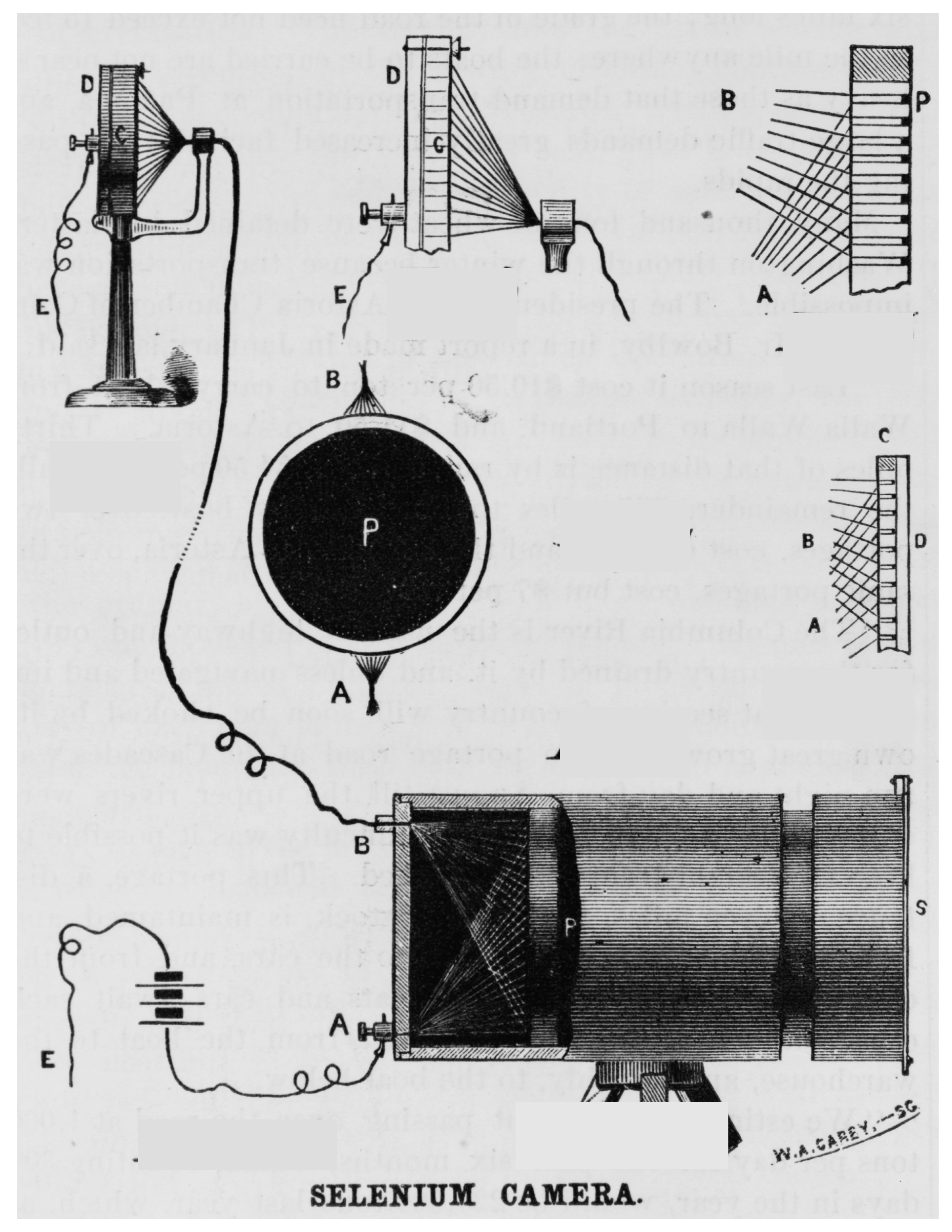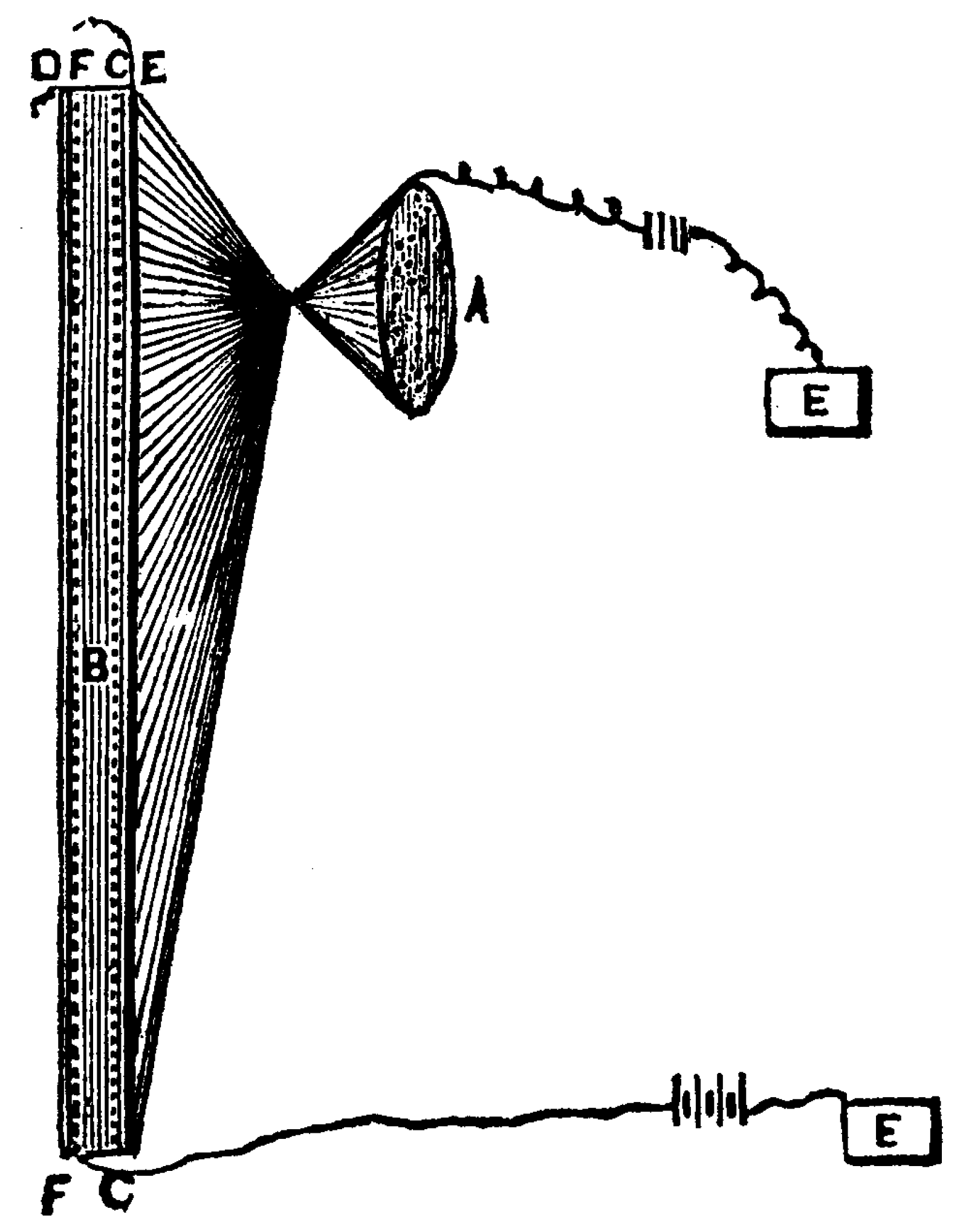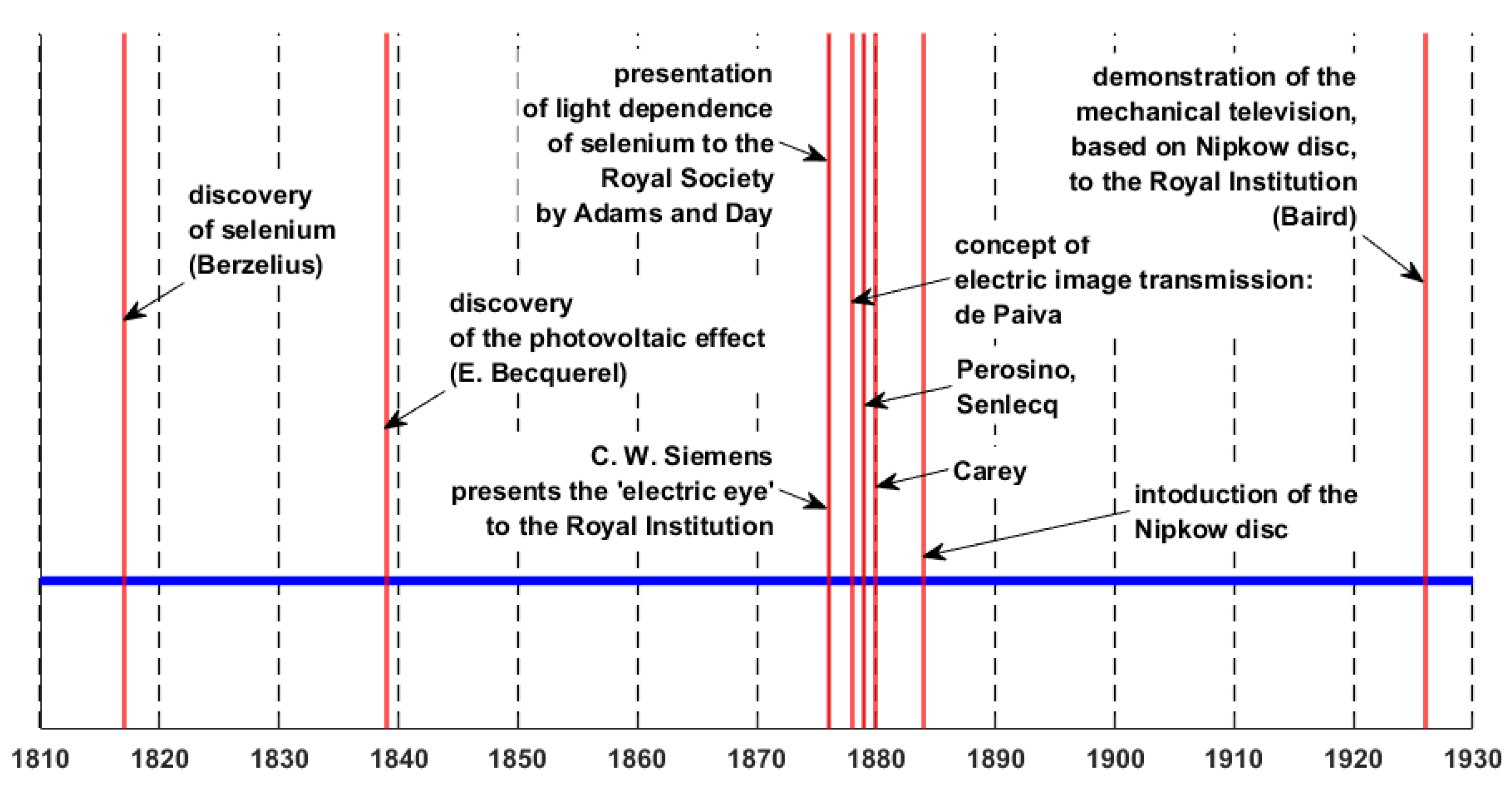Image Transmission and Selenium: Adriano de Paiva and Initial Steps in the XIX Century
Definition
1. Introduction: The Man, the Facts
2. The Influence of the Siemens Brothers
3. Implementation
4. Initial Years of the Notion of Image Transmission at a Distance, The Scientific Priority: 1878–1880
5. The Evolution of the Interest in the Origins of Image Transmission
6. Concluding Remarks
Funding
Institutional Review Board Statement
Informed Consent Statement
Data Availability Statement
Conflicts of Interest
Abbreviations
| ARCL | Academia Real das Sciencias de Lisboa (now Academia das Ciências de Lisboa) |
| FEUP | Faculdade de Engenharia da Universidade do Porto |
| IEEE | Institute of Electrical and Electronics Engineers |
| IET | Institution of Engineering and Technology |
| IFToMM | International Federation for the Promotion of Mechanism and Machine Science |
| RTP | Rádio e Televisão de Portugal |
| SMPTE | Society of Motion Picture and Television Engineers |
References
- de Paiva, A. A telephonia, a telegraphia e a telescopia. O Instituto 1878, 25, 414–421. [Google Scholar]
- de Paiva, A. A telescopia electrica. O Instituto 1880, 27, 169–172. [Google Scholar]
- de Paiva, A. La Télescopie Électrique: Basée sur L’emploi du Sélénium Typ; António José da Silva: Porto, Portugal, 1880. [Google Scholar]
- Benevides, F.F. A luz que falla e o photophone. O Occidente 1881, 4, 127–128. [Google Scholar]
- Benevides, F.F. Parecer acerca do microphotometro electrico do sr. Virgílio Machado. J. De Sci. Math. Phys. E Naturaes 1880, 255–257. [Google Scholar]
- Benevides, F.F. Sobre a acção da luz sobre o selénio. J. De Sci. Math. Phys. E Naturaes 1881, 73–79. [Google Scholar]
- Sousa Pinto, A. A visão à distancia e a transmissão rapida da photographia. Ann. Sci. Da Acad. Polytech. Do Porto 1907, 2, 166–173. [Google Scholar]
- Nipkow, P. Der Telephotograph und das elektrische Teleskop. Elektrotechnische Z. 1885, 6, 419–425. [Google Scholar]
- Brown, F.C. Bibliography of literature bearing on the light-sensitiveness of selenium. Proc. Iowa Acad. Sci. 1916, 23, 241–263. [Google Scholar]
- Singer, C.; Williams, T.I.e.a. (Eds.) A History of Technology, 7 Vols. Plus Consolidated Indexes; Oxford University Press: Oxford, UK, 1954–1958. [Google Scholar]
- Lange, A. Histoire de la Television (et de quelques autres médias). Available online: https://www.histv.net/ (accessed on 25 October 2024).
- Vaz Guedes, M. Telescopia eléctrica com aplicação do selénio: A prioridade da ideia. Electricidade 1999, 47–53. [Google Scholar]
- Vaz Guedes, M. A prioridade de uma ideia: A telescopia eléctrica. Amigos de Gaia 1999, 7, 30–34. [Google Scholar]
- Vaz Guedes, M. História da Electrotecnia. Trabalhos Publicados por Manuel Vaz Guedes Contendo Elementos de História da Electrotecnia. Available online: https://paginas.fe.up.pt/histel/ (accessed on 25 October 2024).
- Roberts, I. ‘Edison’s Telephonoscope’: The visual telephone and the satire of electric light mania. Early Pop. Vis. Cult. 2017, 15, 1–25. [Google Scholar] [CrossRef]
- Roberts, I. Visions of Electric Media. Television in the Victorian and Machine Ages; Amsterdam University Press: Amsterdam, The Netherlands, 2019. [Google Scholar]
- The Sun; 30 March 1877; p. 2. Available online: https://www.loc.gov/resource/sn83030272/1877-03-30/ed-1/?sp=1&r=0.298,0.362,0.631,0.521,0 (accessed on 2 November 2024).
- O telectroscopio. O Commercio do Porto, 4 October 1879; Vol. XXVI anno.
- Commercio do Porto, 7 October 1879; Vol. XXVI anno.
- Galili, D. Seeing by Electricity: The Emergence of Television, 1878–1939; Duke University Press: Durham, NC, USA, 2020. [Google Scholar]
- Arnold, S. Gender and Early Television. In Mapping Women’s Role in Emerging US and British Media, 1850–1950; Bloomsbury Publishing Plc: London, UK, 2021. [Google Scholar]
- Berzelius, J.J. Lehrbuch der Chemie; Grund: Wien, Austria, 1824. [Google Scholar]
- Becquerel, E. Recherches sur les effets de la radiation chimique de la lumière solaire au moyen des courants électriques. Comptes Rendus Des Séances De L’académie Des Sci. 1839, 9, 145–149. [Google Scholar]
- Adams, W.G.; Day, R.E.V. The action of light on selenium. Proc. R. Soc. Lond. 1877, 25, 113–117. [Google Scholar] [CrossRef]
- Siemens, C.W. The action of light on selenium (weekly evening meeting, Friday, 18 February 1876). In Notices of the Proceedings at the Meetings of the Members of the Royal Institution of Great Britain, with Abstracts of the Discourses Delivered at the Evening Meetings; Royal Institution: London, UK, 1876; Volume VIII (1875–1878), pp. 68–79. Available online: https://babel.hathitrust.org/cgi/pt?id=mdp.39015035453250&seq=80 (accessed on 2 November 2024).
- Siemens, W. Über den Einfluss der Belenchtake auf die Leitunee fähigkeit des krystallinischen Selens. Monatsberichte Der Königlichen Preuss. Akad. Des Wiss. Zu Berl. 1875, 280–281. [Google Scholar]
- Siemens, W. Ueber den Einfluss der Beleuchtung auf die Leitungstähigkeit des krystallinischen Selens (1875). In Wissenschaftliche und Technische Arberten; Springer: Berlin/Heidelberg, Germany, 1889; Volume 1. [Google Scholar]
- Bragg, W.L.; Porter, G. (Eds.) Physical Sciences; Elsevier Publishing Company: Barking, UK, 1970. [Google Scholar]
- Schubin, M. What sparked video research in 1877? the overlooked role of the Siemens artificial eye. Proc. IEEE 2017, 105, 568–576. [Google Scholar] [CrossRef]
- Perosino, C.M. Su d’un telefotografo ad un solo filo (23 marzo 1879). Atti Della R. Accad. Delle Sci. Di Torino 1878–1879, 14, 574–585. [Google Scholar]
- Perosino, C.M. Su d’un telefotografo ad un solo filo. (Adunanza del 23 Marzo 1879). Gli Studi Ital. Period. Didatt. Sci. E Lett. 1879, 2, 802. [Google Scholar]
- Accademia Reale delle Scienze di Torino. Adunanza del 23 marzo 1879. Su d’un telefotografo ad un soÏo flio. Gazetta Uff. Del Regno D’italia 1879, 1721–1722.
- A propos du télectroscope. La Lumière Électrique J. Univers. D’électricité, 1 November 1880; Tome II, no. 21, p. 447.
- Seeing by electricity. Sci. Am. 1880, 42, 355. [CrossRef]
- Senlecq, C. Le Télectroscope; Typ. H. d’Homont: Saint-Omer, France, 1881. [Google Scholar]
- The telectroscope. By Mons. Senlecq, of Ardres. Sci. Am. 1881, 4382.
- Lipton, L. Jenkins and Baird. In The Cinema in Flux; Springer: New York, NY, USA, 2021; pp. 631–643. [Google Scholar] [CrossRef]
- Burns, R.W. John Logie Baird: Television Pioneer; The Institution of Engineering and Technology: London, UK, 2000; Volume 28. [Google Scholar]
- da Silva, M.J.L.; Teves, V.H. Vamos Falar de Televisão; Editorial Verbo: Lisboa, Portugal, 1971. [Google Scholar]
- de Sousa, A. O professor Adriano de Paiva e a telescopia electrica. Parte I. Revista Scientifica, July 1882; No. 7., pp. 329–332. [Google Scholar]
- de Sousa, A. O professor Adriano de Paiva e a telescopia electrica. Parte II. Revista Scientifica, August–September 1882; No. 8–9, pp. 394–404. [Google Scholar]
- Pinto Garcia, J. Pertence a um português a pré-história da televisão. Flama, 12 September 1969. [Google Scholar]
- Varella, M. Portugal nas origens históricas da Televisão: Notícia sobre Adriano de Paiva, autor dos primeiros ensaios escritos da transmissão de imagens à distância em 1877; Edição da Casa do Pessoal da Radiotelevisão Portuguesa: Lisboa, Portugal, 1981. [Google Scholar]
- Universidade do Porto. Annuario da Academia Polytechnica do Porto. Anno Lectivo de 1886–1887; Typographia Occidental: Porto, Portugal, 1887. [Google Scholar]
- Universidade do Porto. Annuario da Academia Polytechnica do Porto. Anno Lectivo de 1887–1888; Typographia Occidental: Porto, Portugal, 1888. [Google Scholar]
- Tavares, J.M.R.S.; Vaz Guedes, M.; de Castro, P.M.S.T. The collection of Reuleaux models of the Faculdade de Engenharia da Universidade do Porto, Portugal: Brief historical note and current status. In Proceedings of the IFToMM Workshop on the History of Mechanism and Machine Science, Ithaca, NY, USA, 6–8 September 2006; Moon, F., Ed.; Cornell University: Ithaca, NY, USA, 2006. [Google Scholar]
- Academia Real das Sciencias de Lisboa. Obras offerecidas à Academia Real das Sciencias de Lisboa por diversos auctores nacionaes e estrangeiros desde 1 de maio de 1880 a 31 de março de 1885. In Sessão Publica da Academia Real das Sciencias de Lisboa em 17 de Dezembro de 1893; Typographia da Academia: Lisboa, Portugal, 1893; pp. 81–148. [Google Scholar]
- du Moncel, T. La télescopie électrique. La Lumière Électrique J. Univers. D’électricité 1880, 2, 398–399. [Google Scholar]
- de Paiva, A. La télescopie electrique basée sur l’emploi du Sélénium. Academy 1881, 26. [Google Scholar]
- Franklin Institute of the State of Pennsylvania for the Promotion of the Mechanic Arts. Official Catalog of the International Electrical Exhibition; Burk & McFetridge, Authorized Publishers: Philadelphia, PA, USA, 1984. [Google Scholar]
- Jeremy Norman & Co. Inc. Catalogue 60. In Science, Medicine & Technology, Including Annotated Books and Small Archives; Jeremy Norman & Co. Inc.: Novato, CA, USA, 2018. [Google Scholar]
- Breguet, A. Le photophone de Bell. La Revue Scientifique de la France et de l’Étranger; Librairie Germer Baillière et Cie: Paris, France, 1880; Volume Tome XIX, pp. 290–296. [Google Scholar]
- Revue de Physique. In La Revue Scientifique de la France et de l’Étranger; 3rd Series; Librairie Germer Baillière et Cie: Paris, France, 1881; Volume Tome I, pp. 340–343.
- Leipzig (Ed.) Brockhaus’ Konversations-Lexikon; Brockhaus: Wien, Austria; Berlin, Germany, 1892; Volume 5. [Google Scholar]
- Seeing by electricity. Engl. Mech. World Sci. 1880, 31, 345–346.
- Seeing by telegraph. The Operator. A J. Sci. Tech. Telegr. 1880, XI, 3.
- Shiers, G. Early schemes for television. IEEE Spectr. 1970, 7, 24–34. [Google Scholar] [CrossRef]
- Shiers, G. Historical notes on television before 1900. SMPTE J. 1977, 86, 129–137. [Google Scholar] [CrossRef]
- Shiers, G. Early Television. In A Bibliographic Guide to 1940; Routledge: New York, NY, USA, 2013. [Google Scholar]
- Burns, R.W. Television: An International History of the Formative Years; The Institution of Engineering and Technology in Association with The Science Museum: London, UK, 2007. [Google Scholar]
- Abramson, A. The History of Television, 1880 to 1941; McFarland: Jefferson, NC, USA, 1987. [Google Scholar]
- Abramson, A. 110 Jahre Fernsehen: Visionen vom Fern-Sehen. In Vom Verschwinden der Ferne. Telekommunikation und Kunst; Decker, E., Weibel, P., Eds.; DuMont Buchverlag Köln, Germany, 1990; pp. 146–207. [Google Scholar]
- Zielinski, S. Audiovisions: Cinema and Television as Entr’Actes in History; Amsterdam University Press: Amsterdam, The Netherlands, 1999. [Google Scholar]
- Lipton, L. The Cinema in Flux. In The Evolution of Motion Picture Technology from the Magic Lantern to the Digital Era; Springer: New York, NY, UAS, 2021. [Google Scholar]
- Hornsey, R. The Many-Sidedness of George Minchin Minchin: Educator, Satirist, and Early Pioneer of Television; Springer: Cham, Switzerland, 2023; Volume 248. [Google Scholar]
- Lipton, L. (Ed.) Vision at a Distance. In The Cinema in Flux; Springer: New York, NY, USA, 2021; pp. 619–630. [Google Scholar] [CrossRef]
- Burns, R.W. The History of British Television with Special Reference to the Contributions of John Logie Baird; University of Leicester: Leicester, UK, 1976. [Google Scholar]
- Leonardo, A.J.F. O Instituto de Coimbra e a Evolução da Física e da Química em Portugal de 1852 a 1952; Universidade de Coimbra: Coimbra, Portugal, 2011. [Google Scholar]
- Marshall, P. Inventing Television: Transnational Networks of Co-Operation and Rivalry, 1870–1936; University of Manchester: Manchester, UK, 2011. [Google Scholar]





Disclaimer/Publisher’s Note: The statements, opinions and data contained in all publications are solely those of the individual author(s) and contributor(s) and not of MDPI and/or the editor(s). MDPI and/or the editor(s) disclaim responsibility for any injury to people or property resulting from any ideas, methods, instructions or products referred to in the content. |
© 2024 by the author. Licensee MDPI, Basel, Switzerland. This article is an open access article distributed under the terms and conditions of the Creative Commons Attribution (CC BY) license (https://creativecommons.org/licenses/by/4.0/).
Share and Cite
de Castro, P.M.S.T. Image Transmission and Selenium: Adriano de Paiva and Initial Steps in the XIX Century. Encyclopedia 2024, 4, 1962-1972. https://doi.org/10.3390/encyclopedia4040128
de Castro PMST. Image Transmission and Selenium: Adriano de Paiva and Initial Steps in the XIX Century. Encyclopedia. 2024; 4(4):1962-1972. https://doi.org/10.3390/encyclopedia4040128
Chicago/Turabian Stylede Castro, Paulo M. S. T. 2024. "Image Transmission and Selenium: Adriano de Paiva and Initial Steps in the XIX Century" Encyclopedia 4, no. 4: 1962-1972. https://doi.org/10.3390/encyclopedia4040128
APA Stylede Castro, P. M. S. T. (2024). Image Transmission and Selenium: Adriano de Paiva and Initial Steps in the XIX Century. Encyclopedia, 4(4), 1962-1972. https://doi.org/10.3390/encyclopedia4040128





